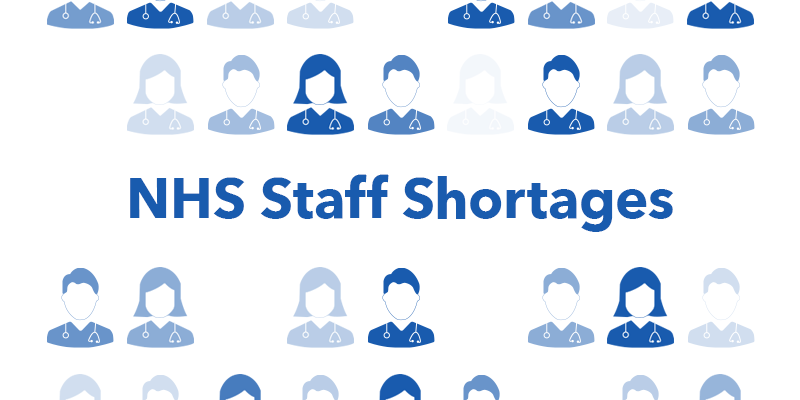As NHS staffing strikes continue to make headlines, Trusts continue to struggle with staff shortages that threaten patient care. The strikes add to what was already an overburdened and understaffed healthcare system. As of September 2022, total NHS vacancies had surpassed 130,000, a vacancy rate of 9.7%. This resulted in an estimated 17,000 nursing posts unfilled on any given day in the NHS.
Strikes, high turnover and the ensuing staff shortages are forcing Trusts nationwide to make difficult decisions on how to care for patients. Many are cancelling patient appointments or turning patients away altogether and sending them to other Trusts. So far, more than one million appointments and operations have been rescheduled.
While the government has agreed to meet consultants, offering some hope of resolving the widespread strikes, the UK’s staffing crisis is one that is long term, and exists independently of worker strikes. According to the NHS Long Term Workforce Plan, low healthcare worker recruitment and an aging national population has the NHS on pace for a shortage of up to 360,000 staff by 2037.
Although the NHS does have a plan to address the shortages, individual Trusts will need to adopt strategies to reduce the impacts of workforce shortages. Among those strategies may be an increased focus on how organisations deliver new hire onboarding and ongoing training.
Improved onboarding can lead to a better caregiver experience and increased satisfaction, helping reduce the risk of burnout and turnover. And with a self-paced onboarding model, Trusts can free up resources and get new hires caring for patients faster, helping maintain adequate staffing levels amid shortages.
How are NHS staff shortages impacting Trusts?
To effectively reduce the impacts of workforce shortages, one must first understand how staff shortages impact NHS Trusts. As mentioned, workforce shortages have a direct impact on patient care. This occurs in many forms, including:
- Increased risk of harm due to long delays in access to care
- Cancelled or rescheduled appointments and surgeries
- Diminishing quality of care
- Waning public satisfaction with NHS healthcare
Perhaps the most challenging aspect of workforce shortages, however, is the negative effect they have on providers, which can further exacerbate the issue. Workforce shortages place additional stress on care providers, leading to overburdened and burned-out staff. This only leads to more turnover, and departures from the healthcare profession altogether, adding to an already complicated problem.
What can NHS trusts do about staff shortages?
While the UK government and NHS leaders work to formulate a long-term plan to address workforce shortages, there are steps individual Trusts can take to lessen the impact. First, Trusts can take steps to help manage staff shortages and make the most of the resources they have on hand. They can also take steps to improve provider satisfaction, which may help retain more staff.
Onboarding strategies for managing NHS staff shortages
Training is a crucial part of any onboarding process, particularly as the NHS navigates its digital transformation and widespread implementation of EPRs. Initial training and onboarding are the most important determinants in EPR satisfaction, a key indicator of caregiver burnout. But with rampant staff shortages and a constant turnover cycle, providing a scalable and consistent onboarding experience can be challenging. Fortunately, a self-paced onboarding strategy offers relief for overburdened training teams and resource-strapped organisations.
Self-paced onboarding enables new hires to work through initial onboarding materials where and when it makes most sense for them or the organisation. With uPerform’s Learning Pathways, training teams can quickly create learning paths based on user role, location or department and deliver it to users even before their first day on the job. Leading health systems around the US have drastically reduced the time it takes to onboard new hires and better respond to workforce crises with this self-paced onboarding model. For example:
- UCHealth now onboards users and grants them access to their Epic EPR in as little as three hours
- When M Health Fairview faced one of the largest nursing strikes in the US, they were able to onboard 1,500 nurses in only five days, enabling them to continue providing quality care to patients.
- Since implementing uPerform, Gundersen Health now onboards new hires up to 75% faster than they did previously
An accelerated onboarding process can help Trusts keep providers on the floor and maximise their ability to care for patients, particularly when facing the short-term impacts of workforce shortages. It can also enable organisations to cross train staff to fill gaps as needed more easily. But this self-directed onboarding strategy can also help NHS Trusts tackle the longer-term challenges that come with workforce shortages, most notably caregiver satisfaction.
Grow your workforce with better training and support
While the ability to accelerate caregivers through initial onboarding at UCHealth, M Health Fairview and Gundersen Health is a sign of hope for Trusts struggling to keep pace with staff shortages, it’s only a viable strategy if the training is effective. Fortunately, all three health systems report positive feedback from caregivers on their new, self-paced onboarding strategy.
Furthermore, uPerform users at Baylor Scott & White Health, which uses a similar model for their ongoing training, rate their Net EPR Experience Score (NEES) 12.9 points higher than nonusers.
If the NHS plans to “train, retain and reform” its way out of the workforce shortage, part of that strategy must include scalable training solutions that support clinical and non-clinical staff through the NHS digital transformation. The widespread implementation of EPRs in the US led to low satisfaction and increased risks of burnout, an additional challenge the NHS cannot afford to take on given current labour market conditions. Fortunately, studies have shown that quality self-directed eLearning can improve EHR satisfaction, trust in organisational leadership, and reduce the risk of burnout.
Related Articles
Optimise training and improve satisfaction with uPerform
Is your Trust preparing for a new EPR implementation or looking to improve proficiency and satisfaction with your current EPR? uPerform enables Trusts to create and deliver tailored Learning Pathways and deliver ongoing training in the flow of work. This self-paced training strategy saves time spent in training, allowing Trusts to keep staff focused on patient care, and improves caregiver satisfaction with their EPR.
Contact us today to learn how uPerform can work for your Trust.





